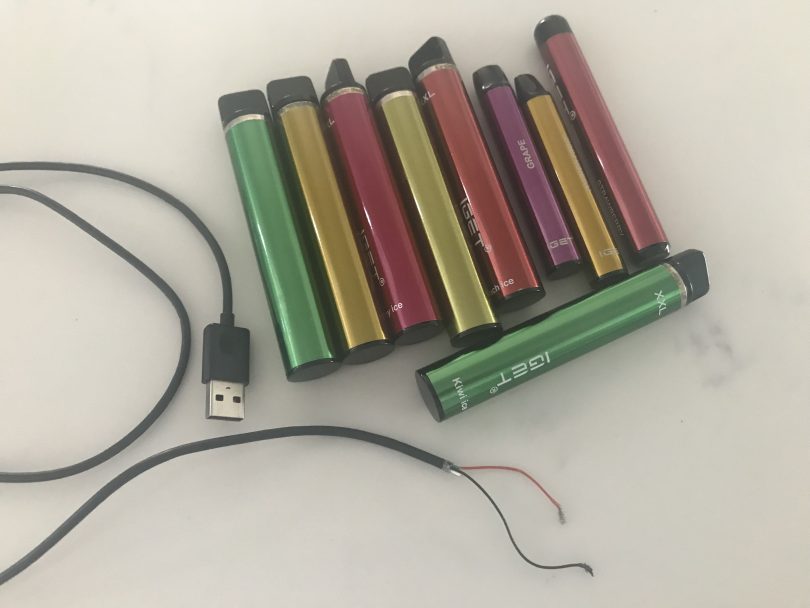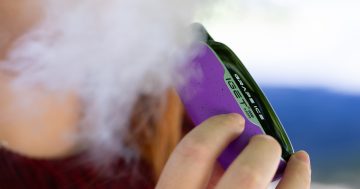
A selection of fruit flavoured vapes popular with young people and a cut USB charger used to recharge ‘dead’ devices. Photo: Region Media.
Let’s be honest, is the recently launched NSW Health ‘Get the Facts’ vaping toolkit and awareness campaign really going to make the so-called ‘cool’ kids think twice about vaping? Probably not.
But, it will educate parents, teachers and carers about the hidden dangers of e-cigarettes and hopefully kick-start conversations in the home and classroom about the harmful, long-term effects vaping can have on the physical and brain development of young people.
Many parents would be totally unaware their child is vaping, but even the best students and sporting stars from all walks of life are being lured into taking ‘hits’ from the colourful, fruity flavoured devices. In the playground, on the school bus and even on the sports field, many kids think vaping is cool.
Most young people know the risk; they know vaping is unhealthy and expensive. Like any trend that just takes off, however, nagging parents, locking school toilets and lengthy lectures from teachers aren’t likely to deter them.
But perhaps likening vape ‘juice’ to household chemicals will make them think twice.
A NSW Health ad campaign, popping up on TV screens, social media and buses, compares chemicals in vapes to those found in household items such as weed killer, fly spray, nail polish remover and disinfectant in an effort to dissuade young people from taking up the habit.
A rising number of teenagers and children as young as 10, are trying or taking up vaping and being exposed to chemicals and toxins such as propylene glycol, glycerol or ethylene glycol.
So, how do you know if your child or teenager is ‘choofing’?
There are many signs to look out for if you suspect your child may be vaping, including coughing, nausea and vomiting, thirst caused by a dry mouth and craving salty food such as chips, cheese and crackers. You may also smell a sweet or fruity aroma in your kids’ room or on their clothing.
If you find strange colourful devices that look like highlighters or USB drives in your kids’ bedroom or school bag, they might be vapes. And if your phone chargers are mysteriously disappearing or you find them with the ends cut off and wires exposed, it’s a sign your child or teen is probably charging vapes.
Many vapes contain nicotine, some at extremely high concentrations, even if they are not labelled as such and evidence suggests they can lead to a lifelong nicotine addiction and increased risk of cancer and cardiovascular and respiratory diseases.
The nicotine in one vape can equal 50 cigarettes and kids who vape are three times more likely to take up smoking
NSW Health Minister Brad Hazzard said research has proven that e-cigarettes are just as addictive and harmful as regular cigarettes.
“A respiratory researcher once told me that e-vaping liquids have chemicals that are similar to antifreeze, with 500 different flavours to attract kids,” Mr Hazzard said.
“It makes it pretty obvious as to the harm it can cause to youngsters’ lungs.”

A NSW Health ad campaign, popping up on TV screens, social media and buses, compares chemicals in vapes to those found in household items. Image: NSW Health.
NSW Minister for Early Learning Sarah Mitchell has urged parents to discuss the dangers of e-cigarettes with their children and to report any usage in schools to principals.
“The number of young people vaping without consideration to the effects is concerning,” she said.
“Educating our young people about the dangers of vaping is essential when there continues to be a large number of reckless individuals selling nicotine products to minors.”
So, how are our kids getting their hands on vapes?
The devices can be purchased online in bulk and sold by ‘dealers’ at school or outside of school, while some kids are buying partially used vapes and charging them using USB chargers to extract the last bit of e-juice from disposable vapes – a bit like the days of smoking someone else’s discarded cigarette butt!
There are a variety of vapes doing the rounds, including refillable devices containing e-juice pods and disposable e-cigarettes in flavours such as kiwi ice, cherry, strawberry, pineapple, passionfruit and mint. Some young people are even using the devices to smoke marijuana.
Dodgy retailers are continuing to sell e-cigarettes and e-liquids containing nicotine to people aged under 18 years, despite facing fines of up to $11,000 for individuals and up to $55,000 for corporations, for first offences.
NSW Health seized more than 100,000 e-cigarettes worth an estimated street value of more than $2 million between 1 July 2020 and 31 December 2021.
If you suspect your child may be vaping, you can get the facts about the dangers of vaping by visiting Vaping: Find the facts.
Original Article published by Katrina Condie on About Regional.










